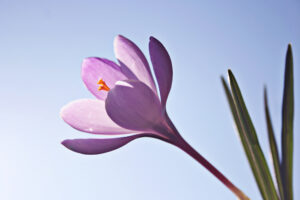Spring offers countless opportunities to foster a love of learning and nature – healthy pursuits for kids that promote natural highs. The signs of spring scavenger hunt creates fun family time and reinforces kids’ natural joy and desire to celebrate spring. You can play this game with kids as young as three.
Why Celebrate Spring with Kids?
Searching for signs of spring helps children (and adults) hone their observation skills. Teaching kids to observe the world around them can prepare them for exciting endeavors. Scientists; writers; artists; inventors; and those wise, self-aware people we sometimes have the privilege of meeting, are all experts at observation in one form or another.

First Signs of Spring Scavenger Hunt
This activity can be a modified scavenger hunt, done over a period of time, or a one-time outdoor family fun activity. Each family member is given a little notebook. As kids and parents go about their daily lives, they search for signs of spring, either as a group or on their own. Families can do this while driving the kids to school, by listening out the window before going to bed at night, or by looking in the neighborhood or yard.
Each person keeps a list of the signs of spring they find. Smaller children can draw pictures. You can make this a theme in the household for a period of weeks or a month as kids and parents go about their daily lives.
Notice When Each Sign is Found
When possible, take note of the date each sign of spring was found. These dates can later be plotted on a calendar and used the following year to anticipate spring. Before long, parents will notice their kids getting excited and joyful when they see the first crocus blooming, or when they hear the call of the red-winged blackbird.
Find the Signs of Spring, Even in Unexpected Places
Signs of spring are different depending on geography. Here are some examples:
- On what day do the birds suddenly start singing in the morning?
- Where in the yard did the sun rise and set all winter? Where is it rising and setting now?
- What birds migrate into and away from your area in spring? What do they look and sound like? Look up the spring birds’ names in a Peterson’s Field Guide, or find and listen to their songs on the internet to learn them.
- Which are the first bulbs or flowers to bloom in the yard or neighborhood? When do the leaf buds appear on the trees? What are the names of the trees and flowers? Look them up or ask an expert from a local nature organization or botanical society.
- Set up different types of bird houses in the yard. Which birds begin making nests first?
- Do the windows get washed in spring, and the closets cleaned out? (People are part of nature too, so things they do also count as signs of spring.) Are parents and kids suddenly noticing people out riding their bikes and walking in the park?
- Are there ponds nearby? Can spring peepers or other night singers be heard when driving past the wetlands at night.
- What does the night air smell like, now that spring is coming or here?
Celebrate Spring as a Family and be Joyful
As everyone adds to their signs of spring lists, praise each child for their efforts. Celebrate each person’s findings by taking a nature walk, purchasing a pair of binoculars to watch the birds at the feeder, writing or reading a poem about spring, baking a ‘welcome home spring” cake, having a party or an outdoor prayer service. Have a meal outside in the yard or park, even if it is not really warm enough.
Better yet, find some newly bloomed crocus or daffodils, grab the kids and form a circle around them. Kick off your shoes, hold hands, jump up and down, and sing “woo hoo, spring is here, spring has sprung!” and run around in the circle until everyone falls down.
Go on… do the happy dance! Your kids will get a big kick out of seeing you in such a joyous state. Betcha anything you’ll enjoy it too!
©Lisa C. DeLuca, all rights reserved. It is a violation of copyright law to reproduce this work on the web or for profit without written permission from the author. This article was originally published on the web in 2008. Please contact the author with your reprint request.
